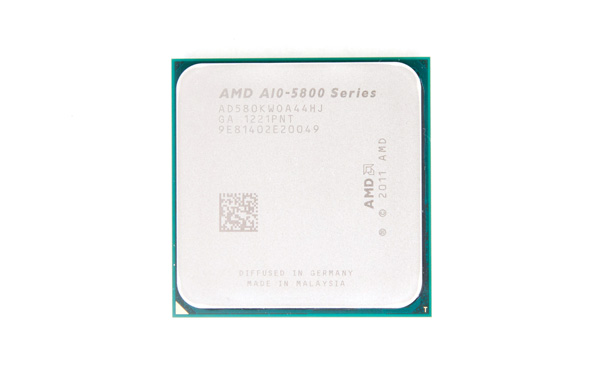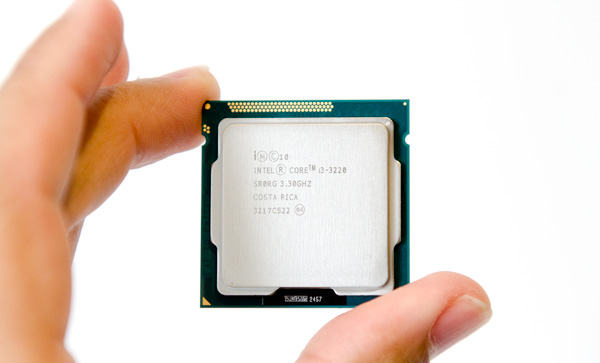AMD A10-5800K & A8-5600K Review: Trinity on the Desktop, Part 2
by Anand Lal Shimpi on October 2, 2012 1:45 AM ESTAlthough AMD's second-generation mainstream APU platform, codename Trinity, launched months ago in notebooks the official desktop launch is today. Rumor has it that AMD purposefully delayed the desktop Trinity launch to clear out unsold Llano inventories in the channel. Although selling APUs in notebooks is pretty easy, convincing desktop users to forgo the discrete GPU option (and ignore Intel) has been a tough battle for AMD. I keep going back to two slides that show us where AMD wants to go and the cores it'll take to get there:

The ultimate goal is this beautiful cohesive operation between CPU and GPU on a single die. That future will require a lot of software support, not only at the application level but also at the OS level. And I'm not talking about Windows 8. We're still far away from this APU dominated future, but AMD is marching in that direction. The second slide shows the x86 cores that we'll see from AMD along the way. AMD is still playing catch-up in the x86 CPU space and it's got a lot of lost time to make up for. There's no hiding the fact this is going to be a multi-year effort to simply get close to Intel's single-threaded x86 performance. Through pricing, leveraging its GPU technology and throwing more transistors at the problem AMD can still deliver competitive solutions, but it's not going to be a walk in the park.
Last week we took a look at the GPU side of the desktop Trinity APUs. We looked at the top end 384-core Radeon HD 7660D configuration as well as the slightly slower 256-core Radeon HD 7560D GPU, both of which easily outperformed Intel's HD 4000 and HD 2500. As far as processor graphics go, Trinity on the desktop maintains a healthy lead over Intel. There's still a place for discrete GPUs but that's pretty much at the $100 and above price points.
Today we're able to talk about pricing and x86 CPU performance among other things. The good news on that front is the most expensive Trinity APU is fully unlocked and is priced at $122:
| AMD Socket-FM2 Lineup | ||||||||
| Modules/Cores | CPU Clock Base/Turbo | L2 Cache | GPU | TDP | Price | |||
| A10-5800K | 2 / 4 | 3.8 / 4.2 GHz | 4MB | 384 cores @ 800MHz | 100W | $122 | ||
| A10-5700 | 2 / 4 | 3.4 / 4.0 GHz | 4MB | 384 cores @ 760MHz | 65W | $122 | ||
| A8-5600K | 2 / 4 | 3.6 / 3.9 GHz | 4MB | 256 cores @ 760MHz | 100W | $101 | ||
| A8-5500 | 2 / 4 | 3.2 / 3.7 GHz | 4MB | 256 cores @ 760MHz | 65W | $101 | ||
| A6-5400K | 1 / 2 | 3.6 / 3.8 GHz | 1MB | 192 cores @ 760MHz | 65W | $67 | ||
| A4-5300 | 1 / 2 | 3.4 / 3.6 GHz | 1MB | 128 cores @ 724MHz | 65W | $53 | ||
| Athlon X4 750K | 2 / 4 | 3.4 / 4.0 GHz | 4MB | N/A | 100W | $81 | ||
| Athlon X4 740 | 2 / 4 | 3.2 / 3.7 GHz | 4MB | N/A | 65W | $71 | ||
Compare this to Llano's launch where the top end SKU launched at $135 and you'll see that AMD is somewhat getting with the times. I would still like to see something closer to $100 for the A10-5800K, but I find that I'm usually asking for a better deal than what most CPU makers are willing to give me.
AMD's competitive target is Intel's newly released Ivy Bridge Core i3 processors. There are only five Core i3s on the market today, four of which use Intel's HD 2500 graphics. The cheapest of the lineup is the Core i3 3220 with two cores running at 3.3GHz for $125. Intel disables turbo and other features (there's effectively no overclocking on these parts), which AMD is attempting to exploit by pitting its Trinity K-series SKUs (fully unlocked) against them. AMD's TDPs are noticeably higher (100W for the higher end K-series parts compared to 55W for the Core i3s). Intel will easily maintain the power advantage as a result under both CPU and GPU load, although AMD's GPU does deliver more performance per watt. Power consumption is a major concern of AMD's at this point. Without a new process node to move to for a while, AMD is hoping to rely on some design tricks to improve things in the future.
At the low end of the stack there are also two Athlon X4s without any active GPU if you just want a traditional Trinity CPU.
The Test
This will be our last CPU/APU review on the current test platform/software configuration. The next major CPU review will see a move to a brand new testbed running Windows 8. As always you can get access to far more numbers than what we report here if you use our performance comparison engine: Bench. Of course if you want to see the GPU and GPU Compute performance of AMD's Trinity APU check out part one of our coverage.
| Motherboard: |
ASUS P8Z68-V Pro (Intel Z68) ASUS Crosshair V Formula (AMD 990FX) Gigabyte GA-F2A85X-UP4 (AMD A85X) Intel DZ77GA-70K (Intel Z77) |
| Hard Disk: |
Intel X25-M SSD (80GB) Crucial RealSSD C300 OCZ Agility 3 (240GB) |
| Memory: | 2 x 4GB G.Skill Ripjaws X DDR3-1600 9-9-9-20 |
| Video Card: |
ATI Radeon HD 5870 (Windows 7) AMD Processor Graphics Intel Processor Graphics |
| Video Drivers: | AMD Catalyst 12.8 |
| Desktop Resolution: | 1920 x 1200 |
| OS: | Windows 7 x64 |













178 Comments
View All Comments
Aone - Wednesday, October 3, 2012 - link
Who being in his right buys high-end discrete GPU for cheap CPU or APU?Plus, those who buy cheap CPUs usually don't have money for high-end discrete GPU.
Gaugamela - Wednesday, October 3, 2012 - link
Here are benchmarks that test the importance of faster RAM in these APUs. The difference in performance is astonishing. http://hexus.net/tech/reviews/cpu/46073-amd-a10-58...By overclocking and using 2133Mhz RAM the A10-5800 can get approximately a 30% increase in 3DMark and some games.
These Trinity APUs seem to be really interesting to tinker with.
creed3020 - Wednesday, October 3, 2012 - link
Thanks so much for posting that. I've been looking for this exact testing of Trinity. AT did this previously with Llano but forgot this crucial test with Trinity.It really helps system builders to set expectations for performance if a client doesn't want to pay for faster memory, or if they do want more performance we can quantify how much an improvement faster memory will have.
mikato - Wednesday, October 3, 2012 - link
Holy molyvozmem - Wednesday, October 3, 2012 - link
Keep encouraging AMD, guys.rarson - Wednesday, October 3, 2012 - link
Why in the world did you not mention which video card you were using on this page? I see that it's mentioned in the test bed, but why the heck do I have to go back and check that when you could have easily mentioned it on the discrete test page?Also, why are you using a 5870 with this? Who the hell is going to pair a new A8 or A10 Trinity with a 5870? That's completely illogical. Couldn't you have tried something newer, perhaps something within the same architecture? Extremely puzzling.
etamin - Wednesday, October 3, 2012 - link
And why was an FX-8150 thrown into the DISCRETE PROCESSOR GRAPHICS benchmark?Hardcore69 - Wednesday, October 3, 2012 - link
HA! Glad I went with an i3 3220 for this office box. Look at the power consumption at load, look at the single threaded benchmarks, even look at the multi threaded benchmarks. AMD is crap. It still hasn't caught up. And there are very few upgrade options compared to Intel. If you want to play games, a dedicated GPU is still vastly better. For other basic tasks, FAIL.rarson - Wednesday, October 3, 2012 - link
You paid more money.They're called trade-offs. That's reality.
Nil Einne - Friday, October 5, 2012 - link
Has anyone come across real world power consumption figures for either the A8-5500 vs A8-5600K or the A10-5700 vs A10-5800K. These have different TDPs, 65W vs 100W and slightly different clocks. But I'm wondering whether the K ones are really that bad in general or it's partially that they wanted more headroom since the K ones are to some extent designed to be overclocked. Of course the different ratings means that you may get unlucky and get a fairly high consumption K processor because of binning but still may be relevent. I'm somewhat out of date and not familiar with how turbo works, but I'm guessing the higher binning means it will stay at turbo for longer so a proper test should also try limiting the K to be the same as the non K just to see if that's the primary reason for any differences. (Ideally also limit the frequencies.)Most reviews including this one seem to be of the Ks I presume because that's what AMD sent out for testing.
Cheers